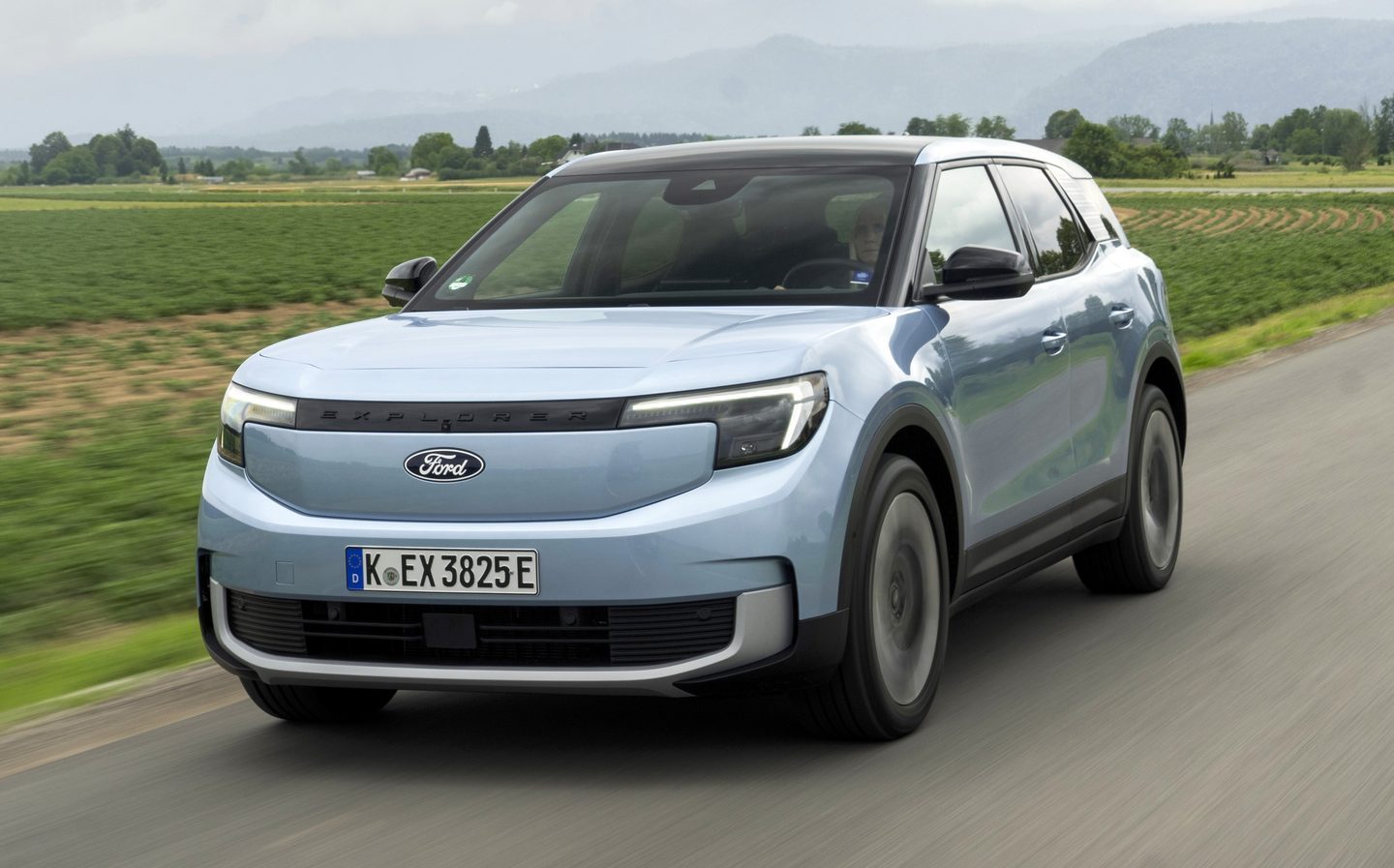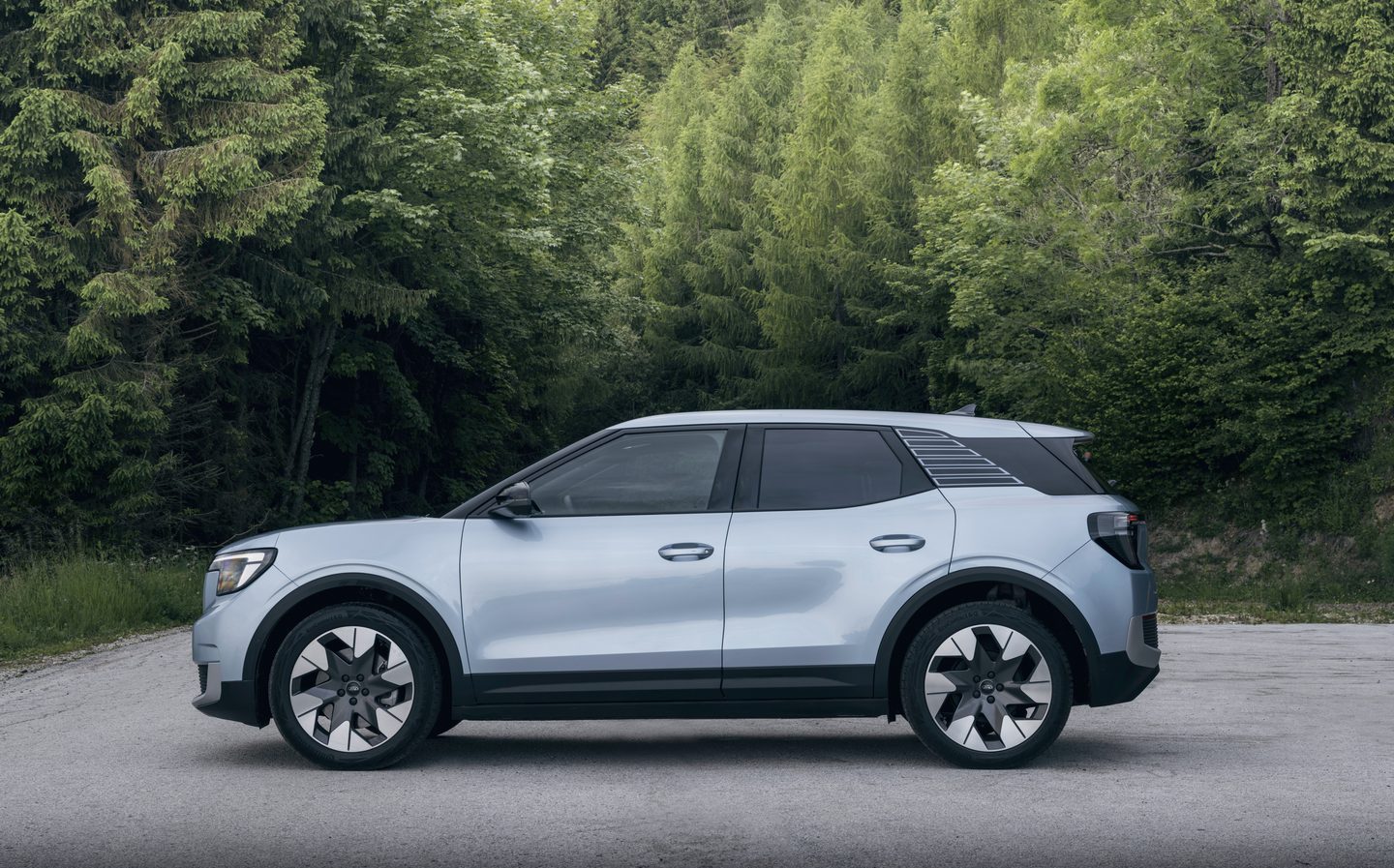Ford Explorer 2024 review: Electric crossover needs to be a monster hit, but is it a Frankenstein’s mismatch of parts?
Watch out in the T. rex enclosure
If you’re of a certain age — crikey, this intro is going to age this writer very badly — and you’re not from North America, then the Ford Explorer probably means two words to you, and two words alone: Jurassic Park.
Famously, the bright, electric-powered tour vehicles which ran through John Hammond’s ill-fated dinosaur attraction were Ford Explorers. And we all know what happened to EXP 04 in that film; the Tyrannosaurus Rex took a great disliking to it, flipping it over and mauling it badly before shoving it down a big drop back into the dinosaur’s own enclosure.

A legendary spot in one of the greatest films of the modern era, it assures the Explorer of immortality in a way. But it also avoids the fact that, outside of some action-movie dino-munching, no one over here in Europe really knows an awful lot about the Ford Explorer name.
Well, the American company is hoping to change all that with its latest electric vehicle (EV), because it has decided to finally bring the Explorer name to the mainstream. But, continuing the filmic/famous story theme, this newcomer borrows lots of its parts from another vehicle, somewhat like Dr. Frankenstein creating his monster.
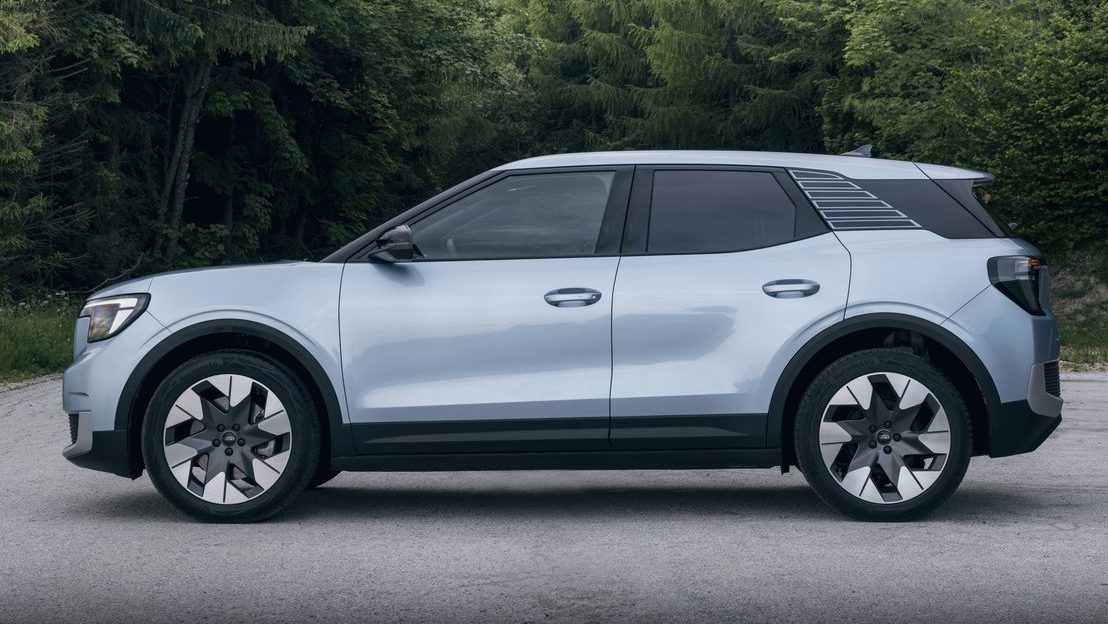
Actually, that’s a trifle unfair on the Ford. And it’s not as if Ford’s association with long-time rival but erstwhile business partner Volkswagen is a big secret.
You see, back in 1995 — about the time that Jurassic Park’s less-brilliant sequel The Lost World was completed in novel form by Michael Crichton — the US car maker teamed up with the Volkswagen Group in a joint venture that gave us the Ford Galaxy, Volkswagen Sharan and Seat Alhambra people carriers.
These three were essentially the same vehicle but with different badges, and while Ford ultimately split away from that collaboration in 2000, the automotive giants have teamed up again.
It’s why the current Ford Ranger pick-up, for example, is the basis for the Volkswagen Amarok truck. Indeed, much of Ford and VW’s tie-ups sit in the commercial-vehicle market.
However, as Ford didn’t have existing midsized SUV electric underpinnings to sit the Explorer on, it instead went to Volkswagen and asked very, very nicely if it could perhaps borrow the ID.4 and ID.5 crossovers to create not only this Explorer, but also the highly contentious reboot of the Ford Capri; and trying to overcome the public opprobrium that ensued in the wake of the new Capri’s reveal is probably as scary to Ford as… as… well, as being attacked by a voracious T. Rex while on a theme park ride.
Anyway, all this means that you don’t have to dig too far down into the new Explorer to spot the Volkswagen influences.
It’s obvious, for instance, with the column-mounted gear-shifter on the right of the steering wheel, that necessitates a Volkswagen Group column stalk on the other side, which firm rules them all; a bit like the One Ring (though perhaps, to avoid confusion, we shouldn’t add yet another film franchise into the review here).
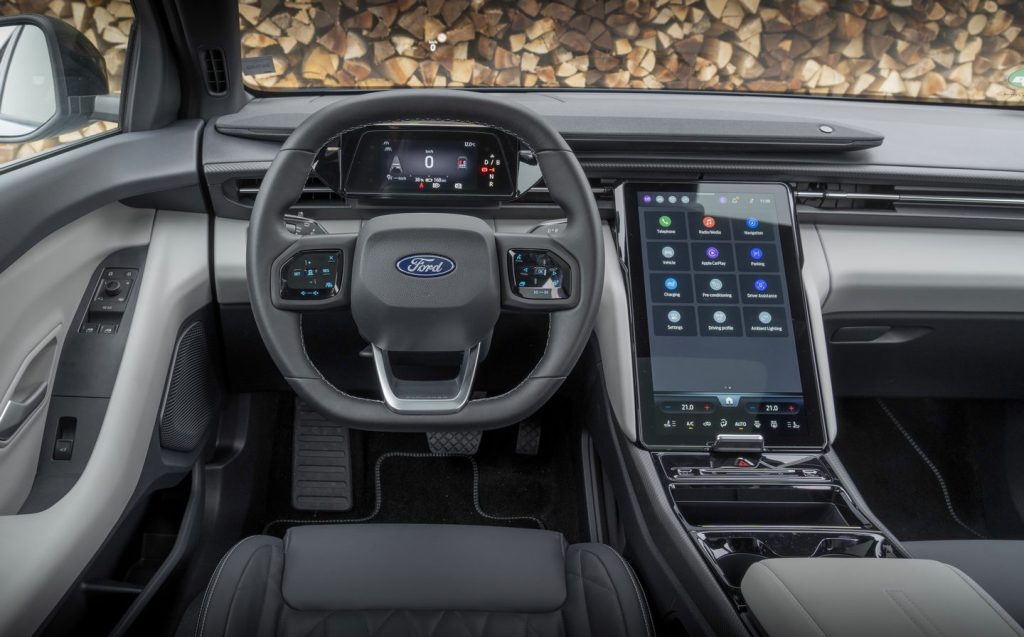
There’s also a pad on the main fascia, again between the steering wheel and the driver’s door, for the lights which will be mighty familiar to you if you’ve driven anything from Volkswagen, Audi, Skoda, Seat or Cupra in recent years.
The joint venture is also evident in the drivetrain choices for the Explorer, which kick off with a single-motor, rear-wheel-drive model with 168bhp and a 52kWh-capacity battery pack, called the Standard Range. There’s then an Extended Range model, which still has just the one rear-mounted motor, but it’s a more powerful one at 282bhp, coupled to a larger 77kWh battery, while an Extended Range AWD variant gets another propulsion unit at the front of the Ford, a slightly larger (79kWh) battery pack and a 335bhp peak output.
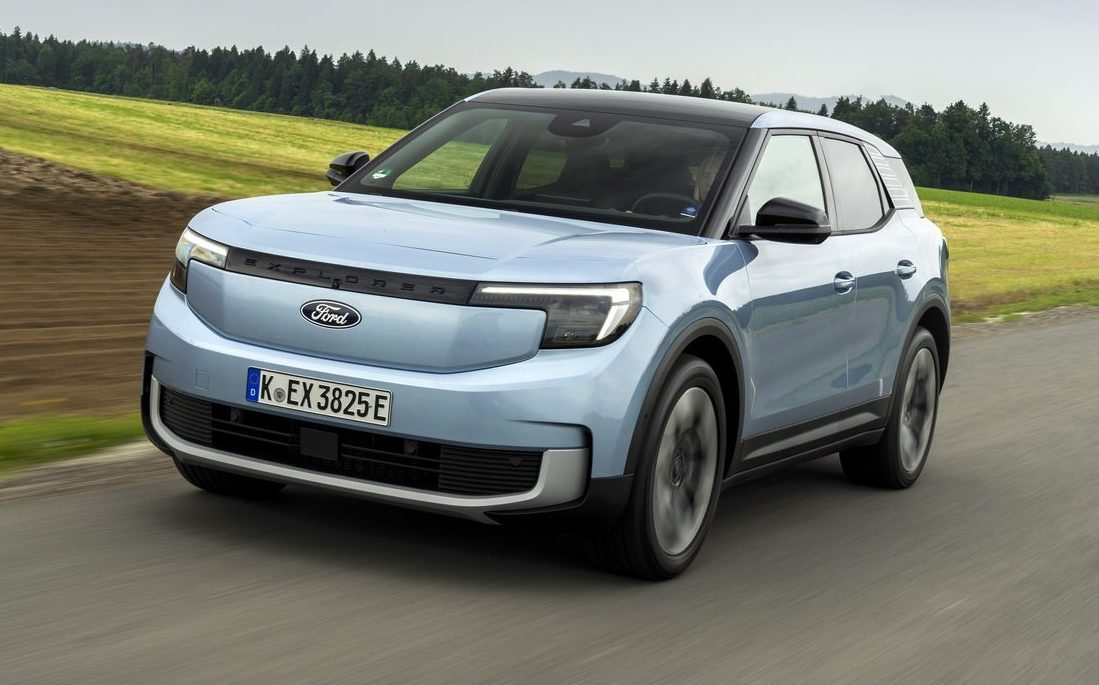
You can get pretty much all the same options in an ID.4, by the way, with the last of these given performance badging as the GTX.
But let’s not do Ford a disservice here. It hasn’t lazily remade a classic film (ahem, EV) and then tried to take all the artistic credit for a fresh product that doesn’t say anything new.
First of all, it should be obvious that the Explorer looks nothing like an ID.4. It’s a much blockier, American-styled creation and, to these eyes at least, it’s all the better for it.
Just two trim levels will be offered by Ford in the UK, which are Select and then Premium. On the latter, 20in wheels are standard but our test car in the grander specification had optional 21in items (at a cost of £1,000) for the maximum of stance.
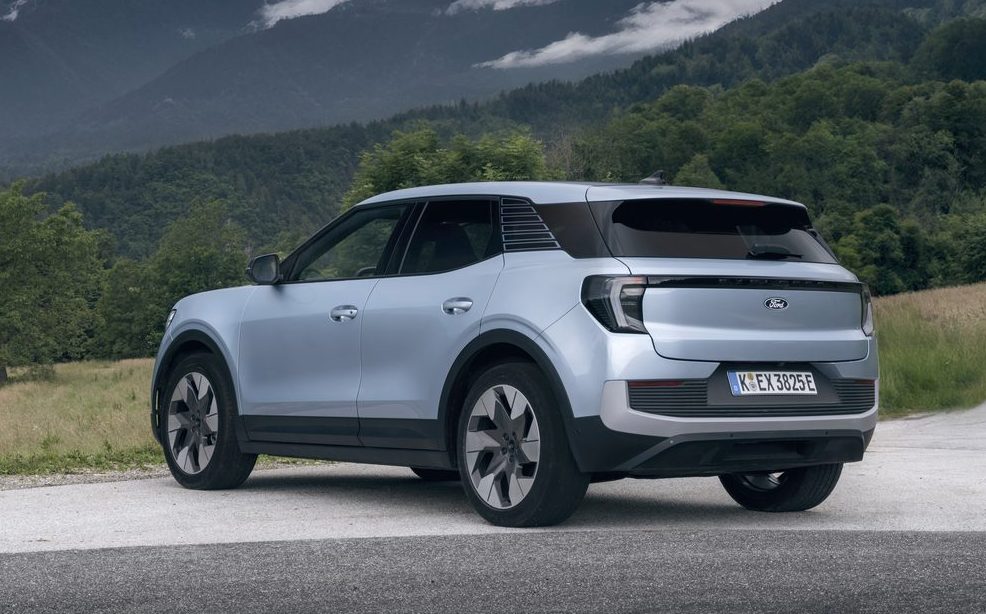
Overall, it really works as a piece of design, and it has a chunky appeal all of its own that’s at odds with the usual EV need to make everything as aerodynamically slippery and smooth-of-shape as possible to maximise battery range.
It’s the same story inside, where the cabin of the Ford is much warmer and homelier than the VW’s rather austere set-up.
Ford has made a design feature of the B&O soundbar on top of the dashboard, choosing not to integrate it into the top surface but instead make it look like some kind of UFO has landed on the fascia. No, we won’t get into Close Encounters of the Third Kind, here.
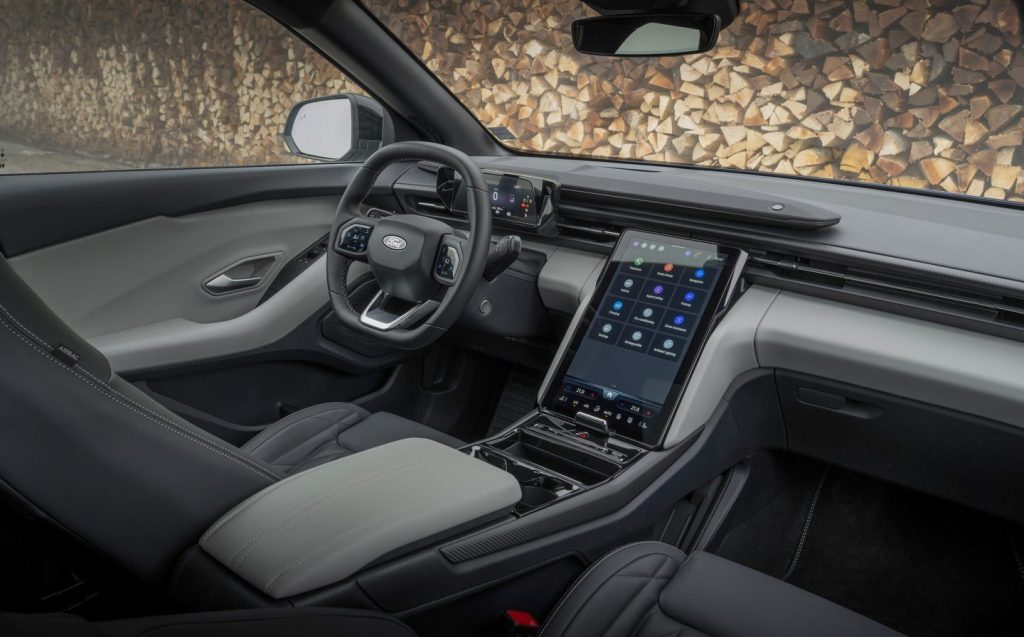
Our Premium car had attractive quilted Sensico (that’s synthetic leather to you and me) on the seats and a light-coloured series of panels around the midriff of the cabin to tastefully break up the otherwise-charcoal-grey interior.
A full-length panoramic roof also helps flood the Explorer’s cabin with plenty of light, so it feels like a suitably upmarket and pleasant place to sit, long before you get to the Ford’s party piece — its Sync Move infotainment system.
The 14.6in central touchscreen, inspired by the one in the larger Mustang Mach-E EV, is presented in a portrait orientation.
But it also slides up and down, tiling through an arc of 30 degrees with a lovely feel as it does, so that owners can either minimise screen glare or position the display just how they like it. Even better, below and behind the screen is a lockable storage compartment that is only revealed when the Sync is completely upright against the dash.
There’s also a 17-litre centre-console storage compartment that you can take to pieces as you see fit, moving cupholders and trays to increase capacity or bolster its versatility as required. Ford calls this the MegaConsole, referencing the “MegaBox” cubicle that’s beneath the boot floor in the smaller Puma crossover.
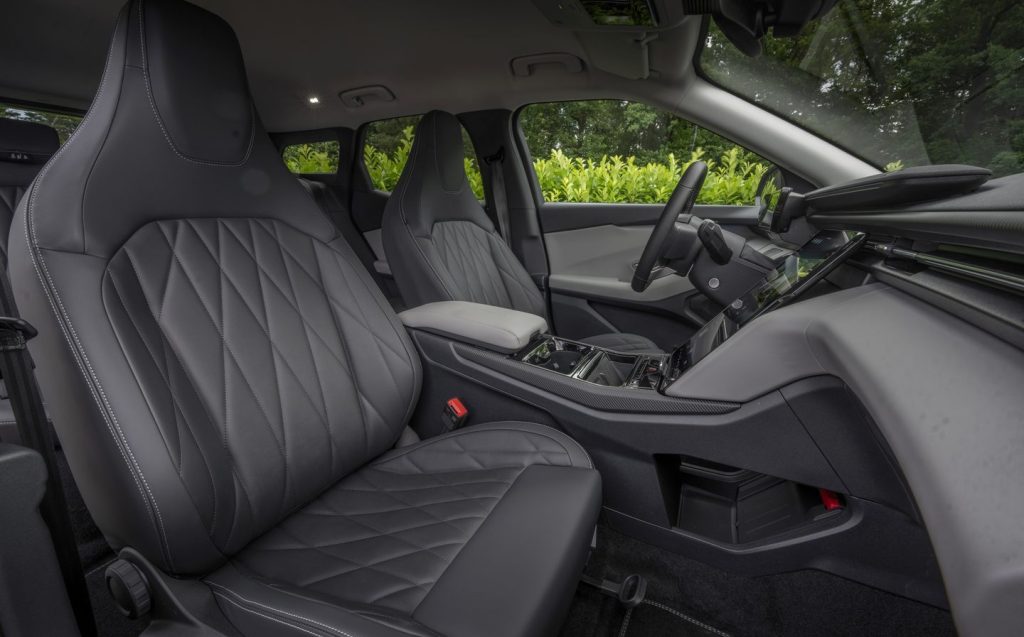
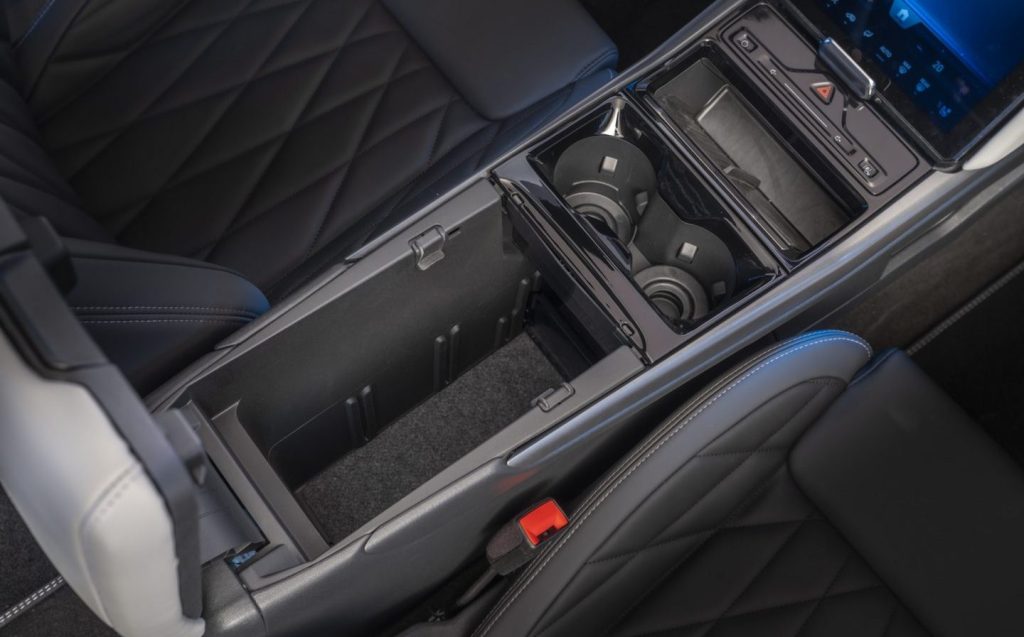
Back in the Explorer, the small screen above the steering wheel and the head-up display in the car also employ Ford’s cleaner, neater font than the Volkswagen script, which is a boon.
And onboard space seems decent enough that four taller adults could sit in the Explorer with little difficulty or discomfort. There’s also a flat floor all the way across in the back, despite a couple of USB ports and air vents on the back of the central console array.
The boot’s not massive, though, measuring 470 litres with all seats in use and 1,422 litres with the rear row folded down. To help keep its exterior design compact and proportional, it also has a high loading lip, further impinging on the usefulness of the Explorer’s cargo bay. For reference, an ID.4’s boot measures 543-1,575 litres, which shows you how much room Ford has sacrificed in the back of the Explorer on the altar of tidy exterior design.
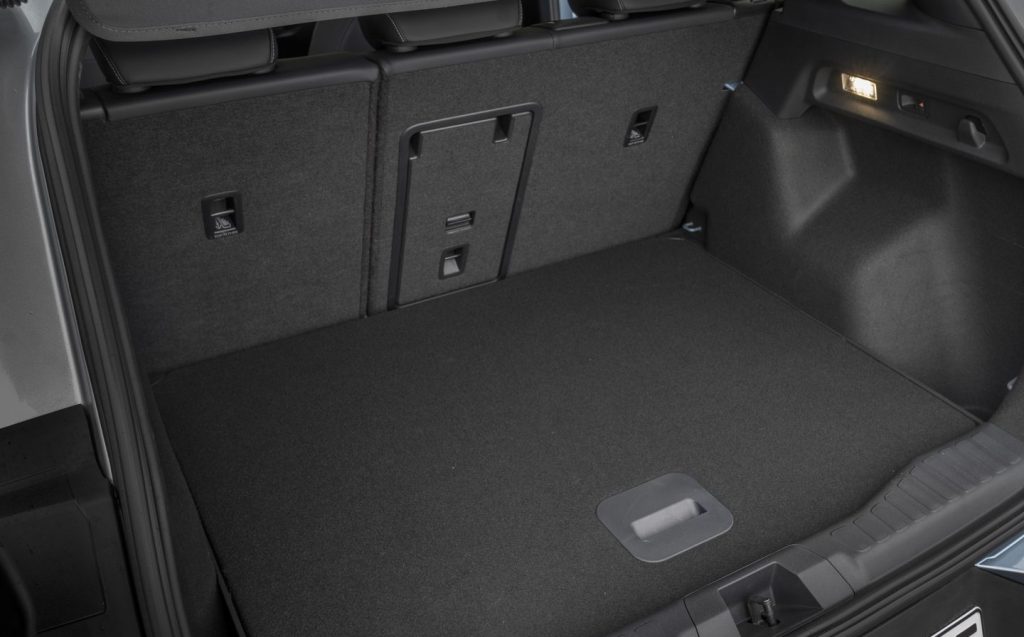
Anyway, what with its lovely material finishing and classier general ambience, we think the Explorer’s cabin is a bigger hit than the Volkswagen source material. Even if the Ford has to use the same daft electric-window set-up in the front, where there are only two switches to control all four side windows.
We also think it drives better than an ID.4, with the caveat that it’s still a 2.1-tonne electric SUV and therefore isn’t the nimblest Ford you’ll ever drive. The company says it has completely re-damped the suspension to tune the Explorer to its own ride and handling preferences and given the way it coped with the varied roads of the New Forest, it would seem Ford has done a cracking job with it.
Even on those gigantic optional 21in alloys, the Explorer doesn’t crash and thump disconsolately around town.
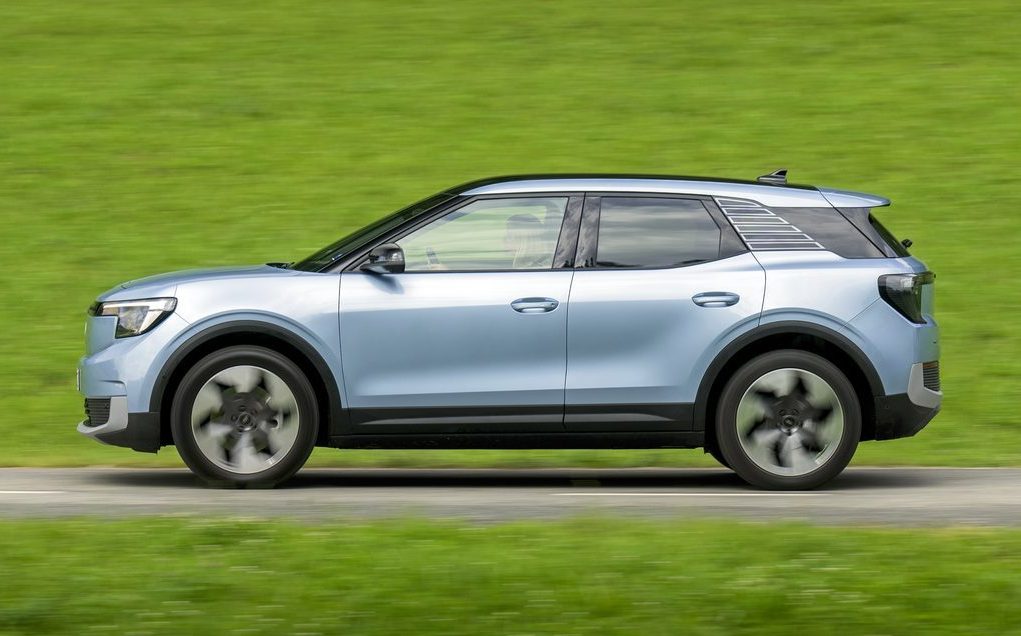
There’s maybe a trace more tyre noise on rougher surfaces and lower speeds than is necessary, but as soon as you go faster or the tarmac improves, that element of the Explorer’s character goes away.
At higher speeds, this is a supremely comfortable and quiet car. It’ll cruise at motorway speeds in a graceful manner, with its square bodywork not creating an elevated level of wind noise at 70mph.
We’d also suggest the 335bhp AWD model is going to be surplus to most people’s everyday requirements, because the 282bhp rear-drive Explorer felt more than quick enough to cope with all motoring scenarios — unless you’re planning to take your electric SUV on a track day somewhere.
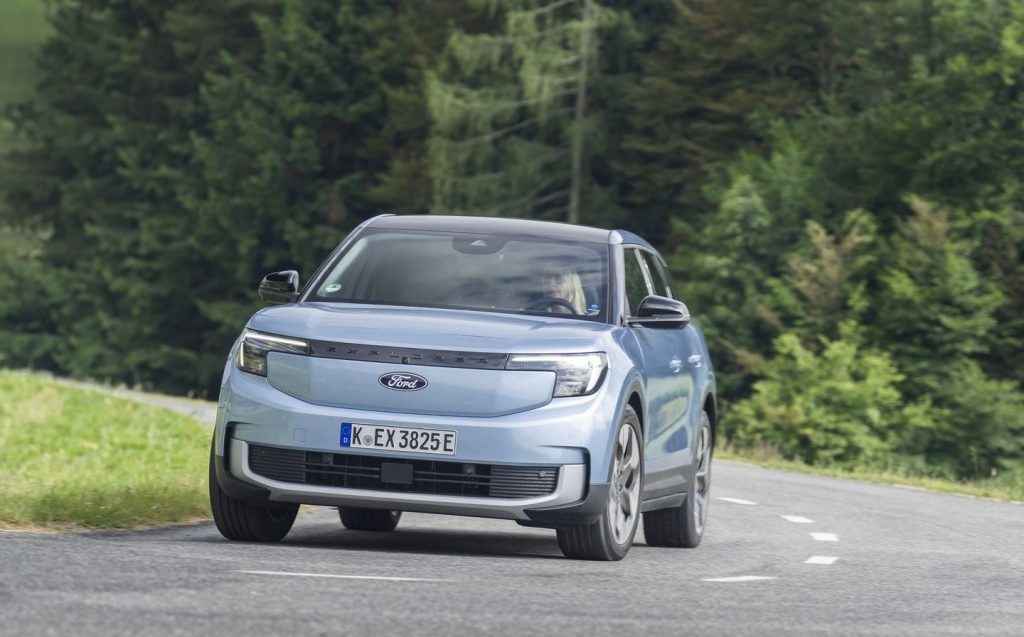
It wouldn’t be terrible on track, by the way, but judging by the way you can sometimes sense the Explorer’s significant mass on the roads — it occasionally needs more braking power than you’re inputting through the pedal, and it doesn’t massively like quick, repeated direction changes at speed — then we’re not talking about one of Ford’s all-time handling greats here.
Nevertheless, the polished and likeable way the Explorer drives in the main will please purchasers no end. As will its substantial range between charges. Stick to a single-motor Extended Range in Select trim and you get up to 374 miles of one-shot driving capability, officially.
The bigger wheels and more generous spec of the Premium trim that back to 354 miles, while opting for the extra performance offered by the AWD — it’ll run 0-62mph in 5.3 seconds, which is considerably quicker than Ford’s own Focus ST hot hatchback — will see the official range drop to 329 miles, as it’s only sold in Premium trim.
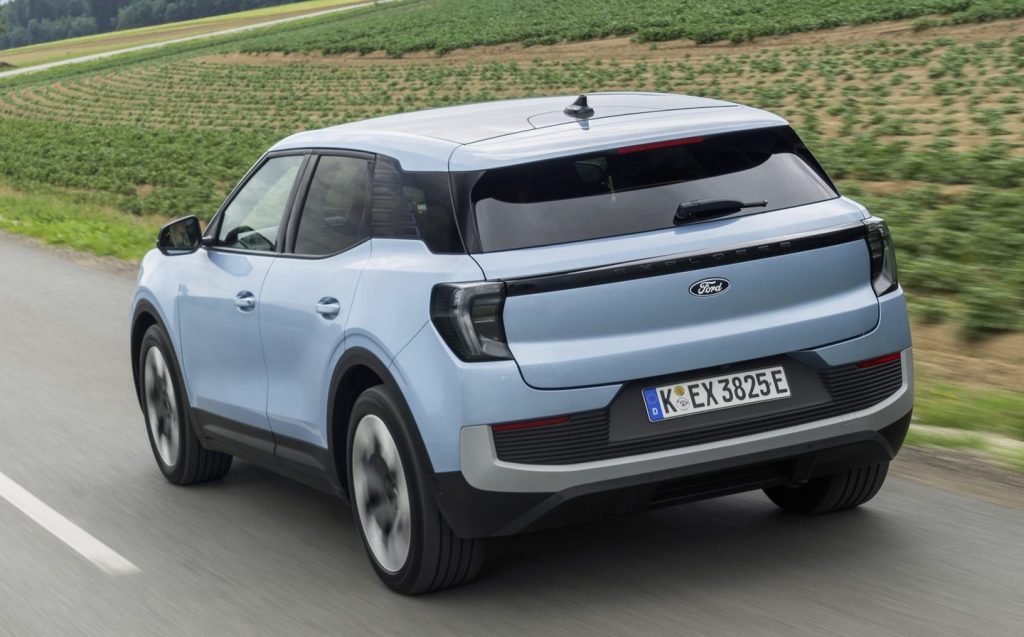
Obviously, as with any EV, take these official figures with a pinch of salt. Colder weather impinges on battery range, as does hilly terrain, using electrical drains in the cabin (like the climate control) and a heavy right foot, but there’s every chance that a realistic 250 miles per charge wouldn’t be out of the question in the Explorer.
Indeed, we saw a very impressive 3.7 miles/kWh indicated from the Ford during our test drive, which would work out at about 285 miles if you could sustain that sort of electrical efficiency for long periods of time.
Charging speeds on DC connections are rapid enough that even when you do need to top the Explorer’s battery pack up, it won’t take an eternity. The 77kWh rear-drive car will take 28 minutes to go from 10-80 per cent at its fastest 135kW speeds, while the 79kWh AWD model can charge a little quicker (185kW) so trims the same replenishment process to 26 minutes.
You’d be looking at anything between 10 and 11 hours to perform a full 0-100 per cent charge on a typical 7.4kWh domestic AC wallbox.
One thing you might want a T. rex to take a bite out of with the Explorer, though, is the price. Again, trying to convince people to switch to electric cars is not going to be easy when they’re always significantly more expensive than an equivalent combustion-powered machine. Ostensibly, the range starts at less than £40,000, but that’s for the 52kWh car in Select specification… and the 52kWh car isn’t coming until 2025.
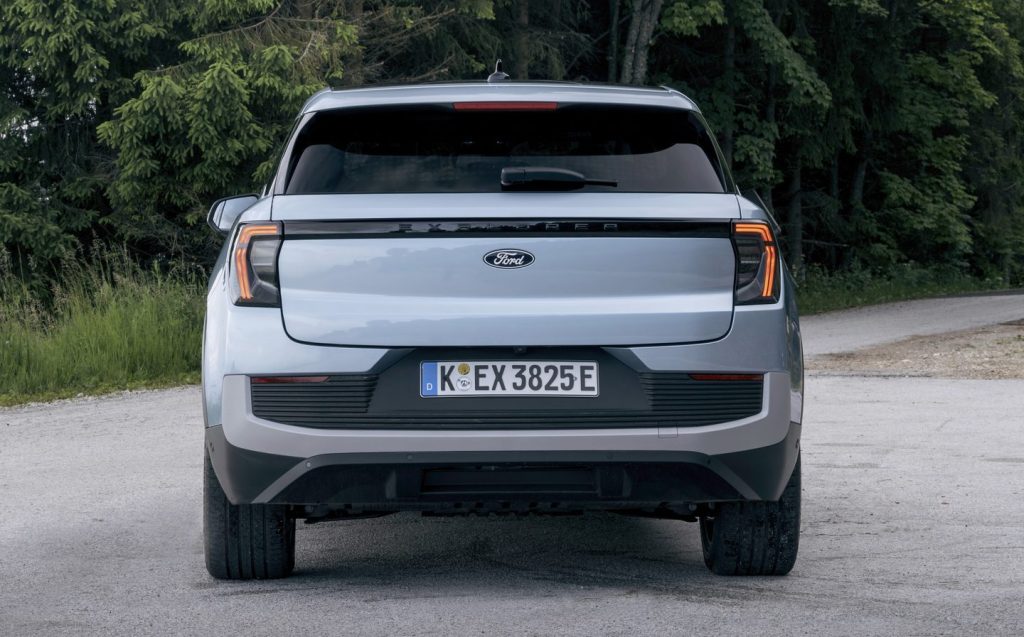
A single-motor 77kWh variant in Premium trim starts from a far heftier £49,975. And with the few options fitted, our test car was pushed to £54,125, a price so large that it might make the surface of a nearby glass of water ripple with ominous intent.
Ford, for its part, says the Explorer is a good three to four thousand pounds cheaper than similar electric SUVs with the same sort of equipment fitted to them. But a 54-grand compact crossover from the Blue Oval is still daunting.
However, if you can get past that — or you can make the monthly costs for it work on PCP or through a company car scheme — then there’s much to like about the new Explorer. It takes a talented existing EV from another manufacturer and improves upon it with smarter looks, a nicer cabin and, arguably, sweeter driving manners. So, it would make a sensible and stylish choice for both private and business users alike.
Just… make sure you keep it away from the king tyrant lizard, and everything should be absolutely fine.
Related articles
- If you found this review of the Ford Explorer interesting, you may want to read our review of the new Ford Capri
- You might like to read about our pick of the best cars of 2024
- Prefer petrol power? Read our review of the Ford Mustang Dark Horse instead
Latest articles
- Porsche 911 Carrera S 2025 review: Harder, better and faster – but is it the best 911?
- F1 2025 calendar and race reports: The new Formula One season as it happens
- Seven great automotive events to visit this summer, from F1 to art and champagne
- Watch new Porsche 911 GT3 smash Nürburgring record for manual cars
- Skoda Elroq 2025 review: Czech carmaker can’t seem to miss with its electric family cars
- Five best electric cars to buy in 2025
- Should I buy a diesel car in 2025?
- Zeekr 7X AWD 2025 review: A fast, spacious and high tech premium SUV — but someone call the chassis chief
- Denza Z9GT 2025 review: Flawed but sleek 1,062bhp shooting brake from BYD’s luxury arm


